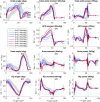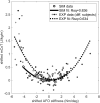Minimization of metabolic cost of transport predicts changes in gait mechanics over a range of ankle-foot orthosis stiffnesses in individuals with bilateral plantar flexor weakness
- PMID: 38846804
- PMCID: PMC11153850
- DOI: 10.3389/fbioe.2024.1369507
Minimization of metabolic cost of transport predicts changes in gait mechanics over a range of ankle-foot orthosis stiffnesses in individuals with bilateral plantar flexor weakness
Abstract
Neuromuscular disorders often lead to ankle plantar flexor muscle weakness, which impairs ankle push-off power and forward propulsion during gait. To improve walking speed and reduce metabolic cost of transport (mCoT), patients with plantar flexor weakness are provided dorsal-leaf spring ankle-foot orthoses (AFOs). It is widely believed that mCoT during gait depends on the AFO stiffness and an optimal AFO stiffness that minimizes mCoT exists. The biomechanics behind why and how an optimal stiffness exists and benefits individuals with plantar flexor weakness are not well understood. We hypothesized that the AFO would reduce the required support moment and, hence, metabolic cost contributions of the ankle plantar flexor and knee extensor muscles during stance, and reduce hip flexor metabolic cost to initiate swing. To test these hypotheses, we generated neuromusculoskeletal simulations to represent gait of an individual with bilateral plantar flexor weakness wearing an AFO with varying stiffness. Predictions were based on the objective of minimizing mCoT, loading rates at impact and head accelerations at each stiffness level, and the motor patterns were determined via dynamic optimization. The predictive gait simulation results were compared to experimental data from subjects with bilateral plantar flexor weakness walking with varying AFO stiffness. Our simulations demonstrated that reductions in mCoT with increasing stiffness were attributed to reductions in quadriceps metabolic cost during midstance. Increases in mCoT above optimum stiffness were attributed to the increasing metabolic cost of both hip flexor and hamstrings muscles. The insights gained from our predictive gait simulations could inform clinicians on the prescription of personalized AFOs. With further model individualization, simulations based on mCoT minimization may sufficiently predict adaptations to an AFO in individuals with plantar flexor weakness.
Keywords: CMA-ES; ankle-foot orthosis (AFO); musculoskeletal simulation; opensim; plantar flexor weakness; predictive simulation; reflex-based neuromuscular controller; scone.
Copyright © 2024 Kiss, Waterval, van der Krogt, Brehm, Geijtenbeek, Harlaar and Seth.
Conflict of interest statement
The authors declare that the research was conducted in the absence of any commercial or financial relationships that could be construed as a potential conflict of interest. The author(s) declared that they were an editorial board member of Frontiers, at the time of submission. This had no impact on the peer review process and the final decision.
Figures






Similar articles
-
The interaction between muscle pathophysiology, body mass, walking speed and ankle foot orthosis stiffness on walking energy cost: a predictive simulation study.J Neuroeng Rehabil. 2023 Sep 7;20(1):117. doi: 10.1186/s12984-023-01239-z. J Neuroeng Rehabil. 2023. PMID: 37679784 Free PMC article.
-
Modifying ankle foot orthosis stiffness in patients with calf muscle weakness: gait responses on group and individual level.J Neuroeng Rehabil. 2019 Oct 17;16(1):120. doi: 10.1186/s12984-019-0600-2. J Neuroeng Rehabil. 2019. PMID: 31623670 Free PMC article. Clinical Trial.
-
Energy cost optimized dorsal leaf ankle-foot-orthoses reduce impact forces on the contralateral leg in people with unilateral plantar flexor weakness.Gait Posture. 2022 Feb;92:71-76. doi: 10.1016/j.gaitpost.2021.11.023. Epub 2021 Nov 20. Gait Posture. 2022. PMID: 34826696
-
Contributions to the understanding of gait control.Dan Med J. 2014 Apr;61(4):B4823. Dan Med J. 2014. PMID: 24814597 Review.
-
The impact of ankle-foot orthosis stiffness on gait: A systematic literature review.Gait Posture. 2019 Mar;69:101-111. doi: 10.1016/j.gaitpost.2019.01.020. Epub 2019 Jan 15. Gait Posture. 2019. PMID: 30708092
Cited by
-
A PRISMA systematic review through time on predictive musculoskeletal simulations.J Neuroeng Rehabil. 2025 Jul 4;22(1):149. doi: 10.1186/s12984-025-01686-w. J Neuroeng Rehabil. 2025. PMID: 40615923 Free PMC article.
References
-
- Bigland-Ritchie B., Cafarelli E., Vollestad N. K. (1986). Fatigue of submaximal static contractions. Acta Physiol. Scand. 128, 137–148. - PubMed
LinkOut - more resources
Full Text Sources

